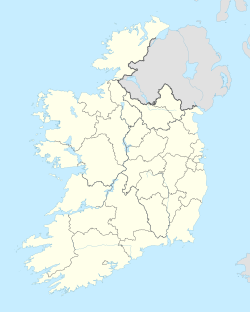world.wikisort.org - Ireland
Letterfrack or Letterfrac (Irish: Leitir Fraic meaning "The Speckled Hill") is a small village in the Connemara area of County Galway, Ireland. It was founded by Quakers in the mid-19th century. The village is south-east of Renvyle peninsula and 15 kilometres (9 miles) north-east of Clifden on Barnaderg Bay and lies at the head of Ballinakill harbour. Letterfrack contains the visitors centre for Connemara National Park.
Letterfrack
Leitir Fraic | |
|---|---|
Village | |
 View of Letterfrack and Ballinakill harbour, 2008 | |
 Letterfrack Location in Ireland | |
| Coordinates: 53.55°N 9.95°W | |
| Country | Ireland |
| Province | Connacht |
| County | County Galway |
| Elevation | 81 m (266 ft) |
| Irish Grid Reference | L697591 |
History
James and Mary Ellis, a Quaker couple from Bradford in England, moved to Letterfrack, during the Great Famine. Ellis became the resident landlord in Letterfrack in 1849.[1] As Quakers, the Ellises wanted to help with the post-famine relief effort. They leased nearly 1,000 acres (405 ha) of rough land and set about farming it and planting it with woodland.[2] They built a schoolhouse, housing for tradesmen, a shop, a dispensary, and a temperance hotel.[3] In 1857 the property was sold to John Hall, a staunch Protestant, and supporter of the Irish Church Mission to Roman Catholics. The ICM used the building with the aim of converting Catholics to Protestantism. After 25 years without much success, Hall sold it in 1882 to the Catholic Archbishop of Tuam, John McEvilly, who used a false name to give Hall the impression that the buyer was a Protestant, for £3000 for 1,000 acres (405 ha).[4][5] In 1885, he established St Joseph's Industrial School, Letterfrack[3] which opened in 1887. Like many other institutions run by the Christian Brothers, Letterfrack Industrial School has since become notorious for excessive use of corporal punishment, neglect, and child molestation of the boys in its charge, and was closed down in 1974.[6][7]
Marconi wireless station
Letterfrack was selected by Marconi as the location for the transatlantic wireless receiver station for his new duplex transatlantic wireless service.[citation needed] It is one of the few Marconi stations still standing in the world.[citation needed] The duplex operation was initially developed by Marconi at Letterfrack using a balanced Carborundum detector with the aerial suspended between Diamond Hill and Mweelin.[citation needed] This later became standard practice for commercial and military radiotelegraph communication worldwide.[citation needed]
Beginning in April 1911, eastbound messages were sent from Marconi Towers, a high power wireless station in Nova Scotia, to Letterfrack; while westbound messages were sent simultaneously from the Clifden high power wireless station to Louisbourg in 1913. The Letterfrack station was moved to Currywongaun and closed in April 1917.[citation needed] Some experimental work on shortwave and other work, by Marconi engineers Franklin and Witt, was carried out into the early 1920s.[citation needed]
St. Joseph's church

In 1924–26 a church was built on the ground of the Industrial School after the designs of the architect Rudolf Maximilian Butler in a Romanesque Revival style. The church was dedicated to Saint Joseph by Thomas Gilmartin on 12 June 1926. The church consists of a single four-bay nave aligned north-south with two small side chapels and an attached sacristy on its western side.[8][9][10]
Atlantic TU (GMIT) campus
![Atlantic TU Campus building in Letterfrack, originally built as St Joseph's Industrial School in 1887 after the designs of the Cavan architect William Hague.[11][12]](http://upload.wikimedia.org/wikipedia/commons/thumb/f/f5/Letterfrack_Former_Industrial_School_2018_09_04.jpg/220px-Letterfrack_Former_Industrial_School_2018_09_04.jpg)
In 1987 the Connemara West began running furniture courses which has become the Furniture College/Campus for the Atlantic Technological University.[13][14]
Media
Connemara Community Radio broadcasts from Letterfrack.
See also
- List of towns and villages in Ireland
Further reading
- Whelan D. (ed.) Founded on Fear; Letterfrack Industrial School, war and exile by Peter Tyrrell. Irish Academic Press 2006. ISBN 978-0-7165-3403-7
References
- "Tánaiste Launches Joan Johnson's book James & Mary Ellis Background and Quaker Famine Relief in Letterfrack". deti.ie. Dept. of Trade and Innovation. 31 July 2000. Archived from the original on 2 August 2012.
- Johnson, Joan (2000). James & Mary Ellis Background and Quaker Famine Relief in Letterfrack. Dublin: Historical Committee of the Society of Friends in Ireland.
- "Living, working and playing in the glow of Diamond Mountain and the shadow of cruelty". Irish Times. 18 August 2010.
- Lyons, Tony. "History of Education Letterfrack" (PDF). dspace.mic.ul.ie. Archived from the original (PDF) on 15 August 2011.
- Gibbons, Michael (2004). Connemara: visions of Chonnacht. Cottage Publications. ISBN 9781900935432.
- "A History of Neglect". paddydoyle.com. 2009.
- "Chapter 8, Letterfrack Industrial School ('Letterfrack'), 1885–1974". Report of the Commission to Inquire into Child Abuse. 2009.
- "Dedication of Letterfrack Church". The Connacht Tribune. 12 June 1926. p. 3.
- "CO. GALWAY, LETTERFRACK, CHURCH (RC)". Dictionary of Irish Architects 1720–1940. Irish Architectural Archive. Retrieved 6 January 2019.
- "Letterfrack, County Galway 30329007". National Inventory of Architectural Heritage. Department of Arts, Heritage and the Gaeltacht. Retrieved 6 January 2019.
- "CO. GALWAY, LETTERFRACK, INDUSTRIAL SCHOOLS". Dictionary of Irish Architects 1720–1940. Irish Architectural Archive. Retrieved 6 January 2019.
- "Letterfrack, County Galway 30329005". National Inventory of Architectural Heritage. Department of Arts, Heritage and the Gaeltacht. Retrieved 6 January 2019.
- "College Building - Galway Mayo Institute of Technology". GMIT.ie. Archived from the original on 11 January 2011.
- "Studying at GMIT Letterfrack". GMIT.ie. ATU - Atlantic Technological University. 20 September 2021. Archived from the original on 1 April 2022.
На других языках
- [en] Letterfrack
[ru] Леттерфрак
Леттерфрак[1] (англ. Letterfrack; ирл. Leitir Fraic)[2] — деревня в Ирландии, находится в районе Коннемара в графстве Голуэй (провинция Коннахт). Она была основана квакерами[3] в середине XIX века. Деревня находится примерно в 3 километрах (2 милях) к западу от Ренвайла и в 15 километрах (9 милях) к северо-востоку от Клифдена.Другой контент может иметь иную лицензию. Перед использованием материалов сайта WikiSort.org внимательно изучите правила лицензирования конкретных элементов наполнения сайта.
WikiSort.org - проект по пересортировке и дополнению контента Википедии